
Effective illumination is crucial in achieving high-accuracy Automatic Number Plate Recognition (ANPR) systems. Whether deployed for traffic monitoring, access control, or law enforcement purposes, the performance of ANPR systems depends largely on how well the camera captures the license plate, and illumination plays a pivotal role in this. Proper lighting ensures that ANPR cameras can identify plates under varying conditions, regardless of environmental factors like ambient lighting, weather, or time of day.
Why Proper ANPR Illumination Matters for License Plate Recognition
ANPR systems rely on high-quality image capture to identify and process license plate numbers. Poor visibility, whether due to insufficient lighting or unfavorable weather, can severely hinder the system’s ability to deliver accurate results. Illumination enhances image clarity, contrast, and reduces noise, which ultimately boosts the accuracy of license plate recognition. This is particularly true in low-light or nighttime environments where license plates are harder to read with the naked eye.
Milesight Intelligent Traffic Series Cameras are designed with advanced lighting features to optimize recognition performance in diverse conditions. These cameras are equipped with intelligent systems that adjust the illumination automatically, ensuring consistent performance in both daytime and nighttime conditions.
Built-In vs. External Illumination
One common question when planning ANPR systems is whether built-in illuminators in the cameras will suffice or if additional external lighting is required. In many cases, the built-in illuminators of cameras such as the Milesight Intelligent Traffic Series Cameras are capable of handling the lighting needs for straightforward license plate recognition tasks.
However, if the project scope expands beyond basic recognition—such as for vehicle occupancy detection, color identification, or tracking—the need for external supplementary lighting becomes apparent. For example, in scenarios where highly accurate images are needed for specific types of license plates (e.g., low-contrast or reflective plates), external infrared illuminators might be necessary.
Some ANPR camera series, such as the Milesight Intelligent Traffic Series Cameras, offer models with integrated supplement lighting that adapts automatically to environmental conditions, covering distances up to 70 meters during the day and 45 meters at night. While beneficial, the choice between built-in and external lighting should be made based on project-specific operational needs.

Choosing the Right Wavelength for ANPR Lighting Solutions
Infrared (IR) lighting is frequently used in ANPR systems because it avoids visible light exposure, reducing the potential for driver distraction. At the same time, it helps capture clear images of license plates, even in complete darkness. Milesight Intelligent Traffic Series Cameras offer two infrared wavelength options: 740nm and 850nm, each serving different operational needs.
- Infrared 850nm
- Semi-Covert Illumination: Infrared 850nm light is ideal for covert operations where minimal light is visible to the human eye, ensuring that the vehicle and license plate are illuminated without causing any noticeable disruption
- High-Quality Nighttime Images: This wavelength is effective in providing clear and well-lit images in low-light and nighttime conditions.
- Best for High-Contrast and Non-Reflective Plates: The 850nm wavelength excels in environments with plates that have a high contrast between characters and the background or non-reflective surfaces, ensuring easy readability.
- Infrared 740nm
- Excellent Low-Light Performance: Positioned just outside the visible spectrum, 740nm infrared light is particularly useful in very low-light conditions, such as urban areas with streetlights or dimly lit parking lots.
- Great for Reflective Plates: The 740nm wavelength is especially effective when dealing with plates that have reflective surfaces or when plates are designed with specific light-reflective materials.
- Capturing Low-Contrast Plates: This wavelength performs well in recognizing plates with subtle contrasts that might be difficult to detect using other infrared wavelengths.

Choosing between these two options depends on various factors, including the type of license plates in the area, the surrounding environment, and the specific needs of your ANPR project.
Regulatory Considerations for ANPR Lighting
When deploying ANPR systems, it is essential to consider local regulations governing the use of illumination. In some countries, legal restrictions prevent the use of visible light for illuminating vehicles and license plates to avoid distracting drivers. In contrast, in some jurisdictions, visible white light may be mandated to illuminate license plates clearly, especially when certain license plate features—like color or background—are crucial for identification.
For example, some countries distinguish between different types of vehicles (e.g., public transport vs. taxis) based on plate color, which requires visible light to differentiate these features. On the other hand, many regions opt for infrared light because it provides a non-intrusive solution while maintaining optimal recognition performance.
As the lighting requirements for ANPR systems are often subject to specific legal frameworks, it’s crucial to research and comply with the regulations in the region where the system will be deployed.
Advanced Illumination Techniques: Frame Parity Flashing for Improved ANPR
In more sophisticated ANPR systems, advanced illumination techniques such as frame parity flashing are employed to further enhance recognition accuracy. Frame parity flashing involves capturing multiple frames of a vehicle using different illumination levels within a short time window. The system then processes these frames and selects the one with the best lighting conditions and image quality for recognition.

This method is especially beneficial in environments with fluctuating lighting conditions or when license plates have varying reflectivity. By capturing multiple frames and selecting the best one, this technique ensures that the system consistently delivers high-quality recognition results.
While not every project requires this level of sophistication, understanding and applying such techniques can be crucial for high-demand scenarios, particularly when operating in challenging environments like areas with fluctuating lighting conditions, nighttime conditions, or reflective plates.
Milesight's Intelligent Traffic Cameras incorporate this innovative technology, ensuring reliable, high-quality results even under the most challenging conditions. This flexibility allows for the optimization of lighting to deliver the best possible recognition outcomes, contributing to the overall effectiveness and efficiency of the ANPR system.
Best Practices for Optimizing ANPR Lighting
To maximize the effectiveness of your ANPR system, it’s essential to consider several best practices when designing and selecting your lighting setup:
- Understand Your Environment:
- Assess the operational environment, including factors such as ambient lighting, weather conditions, and the placement of the cameras. For example, if the cameras are installed in areas with frequent rainfall or fog, the lighting system must be robust enough to overcome these challenges.
- Choose the Right Wavelength:
- The 740nm and 850nm infrared wavelengths offer distinct benefits depending on the plate materials and surrounding lighting conditions. Select the appropriate wavelength based on the reflective properties of the license plates and your project’s goals.
- Adjust Brightness and Intensity:
- Ensure that the lighting is strong enough to illuminate the license plates effectively without overexposing the image. Adaptive systems, such as those offered by Milesight Intelligent Traffic Series Cameras, automatically adjust the brightness to maintain optimal image quality under changing conditions.
- Adhere to Local Regulations:
- Before implementing your lighting solution, make sure it aligns with regional laws and guidelines. This is particularly important when it comes to visible lighting requirements or restrictions on the use of certain wavelengths.
Conclusion: Smart Illumination Makes Smart Recognition
There is no one-size-fits-all lighting solution for ANPR. Environmental factors, legal regulations, plate types, and project-specific goals all play a role in determining the optimal illumination strategy. Thoughtful planning at the outset ensures that the system will deliver reliable, high-accuracy recognition around the clock.
With advanced technologies such as infrared wavelengths and frame parity flashing, Milesight Intelligent Traffic Series Cameras provide a versatile and effective solution for any ANPR application.
If you require technical assistance in selecting the most suitable illumination setup for your ANPR project, our team is available to provide professional guidance based on your specific requirements and deployment scenarios. Please contact sales@milesight.cam.









